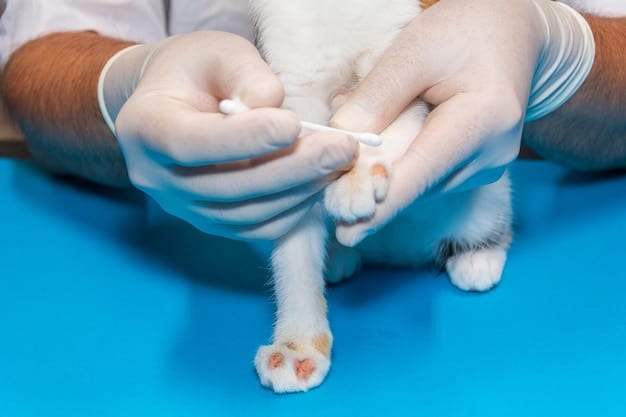Diabetes in Pets: Your Practical Guide to Insulin & Diet Control

Diabetes in pets, a condition requiring careful insulin management and diet control, can be effectively managed with the right knowledge and proactive care, ensuring a better quality of life for your beloved companion.
Understanding and managing diabetes in pets: a practical guide to insulin management and diet control is crucial for ensuring a happy and healthy life for your furry friend. This comprehensive guide will walk you through everything you need to know.
Understanding Diabetes in Pets
Diabetes mellitus, commonly known as diabetes, is a metabolic disorder that affects pets just as it does humans. It occurs when the pancreas doesn’t produce enough insulin or when the body can’t effectively use the insulin it produces.
There are primarily two types of diabetes in pets: Type I, where the pancreas doesn’t produce enough insulin, and Type II, where the body becomes resistant to insulin. Recognizing the symptoms early is crucial for timely intervention.
Common Symptoms of Diabetes in Pets
Identifying the signs of diabetes early can make a significant difference in managing the condition and improving your pet’s quality of life.
- Excessive Thirst (Polydipsia): Your pet may drink significantly more water than usual.
- Frequent Urination (Polyuria): Increased water intake leads to more frequent urination.
- Weight Loss: Despite a normal or increased appetite, your pet may lose weight.
- Increased Appetite (Polyphagia): Your pet may seem constantly hungry and eat more.
Early detection begins with recognizing these signs and seeking veterinary attention. Ignoring these symptoms can lead to more severe health complications, making timely intervention a critical step in managing diabetes in pets.
Diagnosing Diabetes in Your Pet
Diagnosing diabetes in pets involves a combination of clinical signs, physical examination, and laboratory tests. It’s a process that requires veterinary expertise to ensure accuracy and avoid misdiagnosis.
The veterinarian will assess your pet’s overall health and perform specific tests to confirm diabetes and rule out other potential conditions.

Key Diagnostic Tests
These tests help the vet confirm the presence of diabetes and assess its severity, enabling them to create an effective treatment plan.
- Blood Glucose Test: Measures the level of glucose in the blood. Elevated levels are a key indicator of diabetes.
- Urine Glucose Test: Checks for the presence of glucose in the urine, another sign of diabetes.
- Fructosamine Test: Provides an average of blood glucose levels over the past 2-3 weeks, giving a broader picture of glucose control.
A comprehensive diagnostic approach, including these key tests, is vital for accurately diagnosing diabetes in pets and initiating appropriate management strategies.
Insulin Therapy: A Lifeline for Diabetic Pets
Insulin therapy is a cornerstone of managing diabetes in pets. Since many diabetic pets can’t produce enough insulin on their own, regular insulin injections help regulate their blood glucose levels and maintain their health.
Administering insulin becomes a part of your daily routine, but with practice and guidance, it can be managed effectively and safely.
Types of Insulin for Pets
Understanding the different types of insulin available for pets is essential for tailoring the treatment to your pet’s specific needs.
- Short-Acting Insulin: Used primarily in emergencies to quickly lower high blood glucose levels.
- Intermediate-Acting Insulin: Commonly prescribed for daily use, providing glucose control for about 12-24 hours.
- Long-Acting Insulin: Offers prolonged glucose control, often requiring fewer injections per day.
Regular discussions with your veterinarian are crucial for monitoring your pet’s response to insulin and making necessary adjustments to maintain optimal glucose levels.
Proper Insulin Administration Techniques
Proper insulin administration is crucial for effectively managing your pet’s diabetes. Incorrect techniques can lead to inconsistent glucose control and potential complications.
There are several key steps to ensure you’re administering insulin correctly and safely.

Step-by-Step Injection Guide
Following these detailed steps will help ensure you administer insulin safely and effectively, promoting your pet’s well-being.
- Prepare the Insulin: Gently roll the insulin vial to mix it; do not shake.
- Draw the Correct Dose: Use an insulin syringe to draw the exact dose prescribed by your veterinarian.
- Choose an Injection Site: Common sites include the scruff of the neck or the side of the body. Rotate injection sites to prevent irritation.
- Administer the Injection: Gently pinch the skin, insert the needle at a slight angle, and inject the insulin. Release the skin and withdraw the needle.
By mastering these techniques and adhering to your veterinarian’s guidance, you can confidently manage your pet’s insulin therapy, ensuring stable glucose levels and improved health.
The Importance of Diet in Managing Pet Diabetes
Diet plays a pivotal role in managing diabetes in pets. What your pet eats directly impacts their blood glucose levels, making a consistent and controlled diet essential.
A well-planned diet helps stabilize glucose levels, reduce the need for high insulin doses, and maintain a healthy weight, all of which contribute to better diabetes management.
Key Dietary Considerations
These guidelines will help you create a diet that supports your pet’s diabetes management and overall health.
- Consistent Meal Times: Feed your pet at the same times each day to align with insulin injections.
- High Fiber Content: Fiber helps slow down the absorption of glucose, preventing spikes in blood sugar.
- Moderate Protein and Fat: These nutrients help maintain a healthy weight and provide sustained energy.
Partnering with a veterinary nutritionist can provide tailored dietary recommendations that meet your pet’s specific needs, ensuring optimal diabetes management through diet.
Monitoring and Adjusting Treatment
Continuous monitoring and treatment adjustments are essential components of effectively managing diabetes in pets. Diabetes management isn’t a static process; it requires ongoing attention and adaptation.
Regular monitoring helps you and your veterinarian assess how well the current treatment plan is working and make necessary adjustments to maintain optimal glucose control.
Tools for Monitoring Glucose Levels
These tools help you stay informed and proactive in managing your pet’s diabetes, leading to better health outcomes.
- Home Glucose Monitoring: Using a pet-specific glucometer to check blood glucose levels at home.
- Urine Glucose Testing: Monitoring urine for glucose, although less precise than blood glucose monitoring.
- Regular Veterinary Check-ups: Routine visits to the vet for comprehensive assessments and adjustments to the treatment plan.
Being proactive with monitoring and working closely with your veterinarian ensures that your pet receives the best possible care, leading to a stable and healthy life despite their diabetes.
| Key Point | Brief Description |
|---|---|
| 💧 Hydration | Ensure constant access to fresh water due to increased thirst. |
| 💉 Insulin | Administer insulin as prescribed by your vet at consistent times. |
| 🍖 Diet | Feed a consistent, high-fiber diet to stabilize glucose levels. |
| 🩺 Vet Visits | Regular check-ups are crucial for monitoring and adjusting treatment. |
Frequently Asked Questions (FAQ)
▼
Look for increased thirst and urination, weight loss despite normal appetite, and increased hunger. If you notice these signs, consult your veterinarian for testing and diagnosis.
▼
Insulin is typically administered once or twice daily, depending on your veterinarian’s recommendation. Consistency is key, so give insulin at the same times each day, coordinated with meal times.
▼
High-fiber diets are often recommended as they help slow glucose absorption. Your veterinarian can recommend a specific diet tailored to your pet’s needs, considering weight, breed, and overall health.
▼
In most cases, diabetes in pets cannot be cured but can be effectively managed with insulin therapy, diet, and regular monitoring. Some cats may experience remission with early and aggressive treatment.
▼
If you miss a dose, consult your veterinarian. Do not double the next dose. Monitor your pet for signs of hypoglycemia (low blood sugar) or hyperglycemia (high blood sugar) and follow your vet’s instructions.
Conclusion
Managing diabetes in pets: a practical guide to insulin management and diet control requires commitment and proactive care. By understanding the condition, following veterinary guidance, and maintaining a consistent routine, you can provide your beloved pet with a happy, healthy life.





